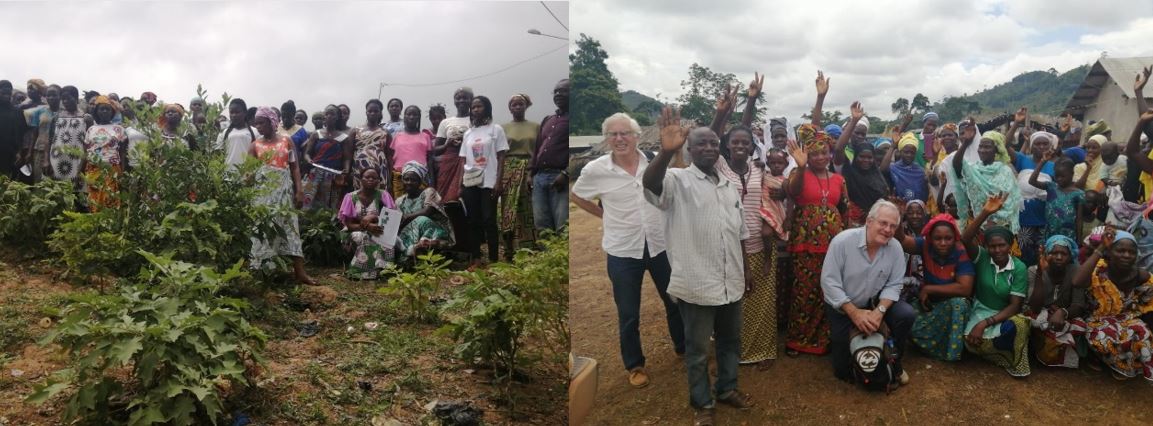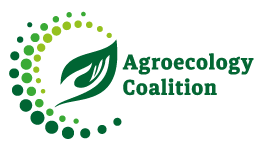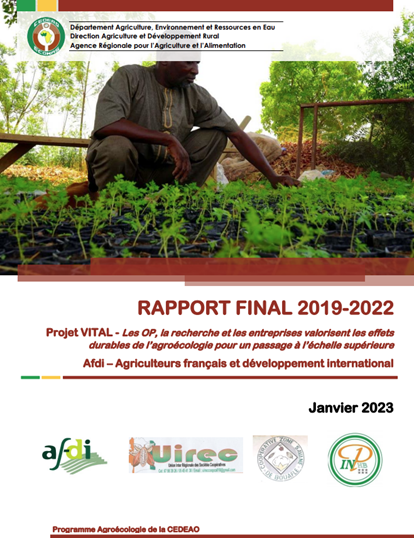The VITAL project – Farmers’ organizations, research and businesses harness the sustainable effects of agroecology to scale up their operations
This project focuses on the San Pedro region of Côte d’Ivoire, home to the world’s largest cocoa port, where agroecology is underdeveloped. From 2019 to 2022, this project enabled small cocoa and market garden producers to implement agroecological and agroforestry practices. The reduction of synthetic inputs (principle 2), soil health (principle 3), economic diversity (principle 7) and the co-creation of knowledge (principle 8) are the principles and elements of agroecology at the heart of this project.
Lead organization
- Union Inter-Régionale des Sociétés Coopératives (UIREC) : a farmers’ organization comprising 25 cooperatives involved mainly in cocoa production. UIREC has been practicing agroforestry and agroecology for several years. The organization strengthens the economic and financial capacities of its members, and also offers training in good farming practices. UIREC is a member of the Alliance for Agroecology in West Africa.
- French Farmers and International Development (AFDI): an international solidarity association that supports family farmers in their efforts to make a decent living from their work and ensure the next generation of farmers, both on their own farms and within farmers’ organizations.
- Institut National Polytechnique Houphouët Boigny de Yamoussoukro (INPHB): a public institution for higher education, research and production, comprising 9 schools and located in Yamoussoukro, Côte d’Ivoire.
- Société coopérative de la zone des Savanes à Bouaflé (SCZSB) : a corn producers’ cooperative.
Country
San Pedro region of Côte d’Ivoire.
Timeline
The project started in 2019 and was completed in 2022.
Funding
USD 364,769 (CFA francs 219 million) funded by the French Agency for the Development (AFD) and the Economic Community of West African States (ECOWAS).
Mission
- Intensify agroecological practices to bring economic and environmental sustainability to family farms.
- Carry out collaborative experimentation with appropriate agroecological practices on cocoa and maize. Disseminate the results of these experiments and market the products resulting from these practices.
- Involve rural civil society, research and producers’ organisations in the co-construction of experimentation, awareness-raising and training schemes for agroecological practice
Context
Agroecology is underdeveloped in San Pedro, the world’s largest cocoa port. The region faces extreme climatic conditions (droughts and violent winds). Soil fertility is declining due to the overuse of synthetic inputs, monoculture and intensive ploughing. The region is also facing increased deforestation due to mining, agricultural expansion (especially in the area of the St. Lawrence River), and the loss of forests. According to Mighty Earth, in 2020, 7,000 hectares of forest were cleared in the country for cocoa production, wood production for energy purposes, and the increase of bushfires.
Côte d’Ivoire is the world’s leading producer of cocoa beans (2 million tonnes produced per year) covering 40% of the world’s supply. This contributes 15 to 20% of its GDP, employs nearly 600,000 growers and supports almost a quarter of the population. 98% of cocoa is produced by family farmers, grouped together in cooperatives which, despite some difficulties, manage to increase the resilience of producers. Given that 67% of Ivorian cocoa is consumed in Europe, communications and initiatives between the European Union and Côte d’Ivoire have been published to combat deforestation.
Main beneficiaries
Cocoa growers (average size of cocoa plots : 2.5 hectares) and market gardeners.
Strategy
Activities
Featured principles and elements:
Economic diversification and connectivity, recycling, input reduction, soil health and synergy, and co-creation of knowledge
- An agrarian diagnosis and a market survey, both carried out at the start of the project in 2019. These two documents highlighted a lack of maintenance of cocoa plantations (the average size of cocoa plots is 2.5 hectares), a lack of pruning of cocoa trees, a lack of adjustment of cocoa tree densities, poor application of chemical or biological fertilisers, and the presence of cocoa brown rot. These observations guided the choice of agroecological experiments to be carried out with producers, as well as the promotion of agroecological products on the market.
- Setting up 18 experimental plots with the aim of demonstrating the effectiveness of agroecological practices, and training producers in these practices. In the cocoa sector, experiments focused on good cocoa farm maintenance practices (organic fertilisation and density adjustment) and on agroforestry (choice of species based on their contribution to soil fertility, their ability to provide shade, and the additional income they can generate by producing fruit or wood). In the corn sector, conservation agriculture practices were tested (no-till and direct seeding, crop associations, biofertilisers).
- Create and train a network of 15 animators and 40 relay farmers to lead interventions on the experimental plots, promote the dissemination of practices (biochar, bio-inputs, pruning, etc.) to other growers, strengthen management and good governance capacities, and better include young people within the cooperatives.
- Organise open days and participate in radio broadcasts to raise the profile of the project and of agroecological practices among the general public.

Effects and Impacts
Monitoring and Evaluation Methods
Together with INPHB researchers, the network measured the social, economic and environmental performance of these systems.
- To assess soil health, samples were taken at the beginning and end of the project.
- For the impact of training on trainees, a survey was carried out in August 2022 to estimate how many trainees (sample of 25%) put into practice the agroecological techniques acquired during training.
Outcomes and Lessons Learned
Outcomes
- Over 1,000 producers in the UIREC network have benefited from institutional and technical support.
- Between 2020 and 2022, 3,147 hours of training were provided for UIREC members (790 men and 161 women).
- 100% of those surveyed have implemented agroecological practices, but the survey was not precise enough to extrapolate the type of practices implemented.
- Monoculture plots have been transformed into agroforestry plots.
- Synthetic inputs have been eliminated and replaced where necessary by biofertilisers.
- In San Pedro, improved levels of chemical elements (NPK, carbon, etc.) were recorded in the soil where biofertilisers were used.
- 87% of respondents noted a reduction in pest attacks on cocoa over the past 2 years.
- Good practices on cocoa trees have resulted in an increase in productivity from 300 kilos per hectare produced annually to over 750 kilos today. 100% of respondents have increased their cocoa production between 2019 and 2021 (average increase of 7.2% from 2019 to 2020; 8% from 2020 to 2021, and 15.8% from 2019 to 2022).
- Growers’ incomes have risen thanks to economic diversification and reduced costs.
- 99% of respondents believe that their expenditure on cocoa cultivation has fallen thanks to the reduction in pests.
Lessons Learned
- The process of transitioning to agroecology and agroforestry has been promoted through communication with the general public and dialogue with natural resource management companies, consumer organisations and political representatives.
- A quality approach is being considered with 200 producers from 5 cooperatives, with the aim of certifying their products as organic via the ECOCERT label, but the high cost of such certification is leading UIREC to look for a customer for organic cocoa prior to certification.
- Economic diversification is crucial: 66% of respondents have other sources of income than cocoa, mainly rubber, oil palm, rice and corn. 100% of respondents feel they have earned a better living over the past 2 years.
-
Contact
UIREC, uireccoopca018@gmail.com

